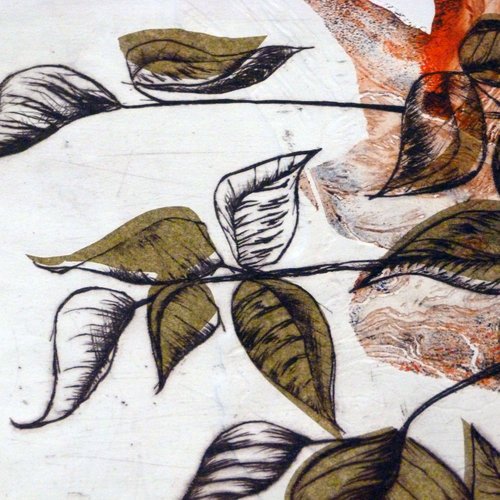How I learned about printmaking
I was 18 when I first did some printmaking, and I found it almost by accident. I had done fine art for A Level at school, which meant we basically only used paint, pencils and pastels to make as realistic an image as we could manage. I went to a grammar school that favoured science above all else. I was an art and humanities girl, so I don’t think they knew what to do with me. It is usual for art students to do a foundation course before attending university, but nobody at my school knew that, so I was encouraged to apply to University straight away, just the one- Edinburgh University- because who would deny a student doing 5 A-levels and a GNVQ on the side, having already achieved very high AS results? Of course I didn’t get in. I lacked the talent and experience. I was the highest achieving student to not have a university place at my school. Eventually I was put in touch with a student from a previous year, which is where I learned about the existence of an art foundation course. We talked on the phone, and she told me how much fun it was. I liked the idea of art classes for a full year, so I enrolled on a course.
My art foundation course was split into four specialities; fine art, digital art, sculpture and printmaking. We spent the first term experimenting, and then the last two terms were to focus on our speciality. We could voice a preference, but the specialist tutors ultimately decided what we studied. I chose fine art, because that’s where I felt safe, both artistically and mentally. A girl who bullied me at Junior school wanted to do printmaking, and she was popular and still disliked me, so I was keen to distance myself. The Fine Art tutor did not want me, but Shelley did. Shelley Burgoyne was the printmaking tutor and she was magic. It seemed like she knew everything, and she threw ideas at us and to try out. I took every idea she had as an instruction and went to town learning all I could. My favourite piece of equipment was the etching press. It basically looked like a mangle, which you could roll a piece of paper through together with a textured surface and the pattern would emboss onto the paper. Add ink to some scribbles on a piece of metal and you’ve got yourself a drypoint print. I loved it. Chin collé was also a lot of fun- where you add pieces of tissue paper between your paper and your metal, which would give your print an extra pop of colour different in texture from the printing ink- prints with collage! I loved it. With nobody to socialise with, and nobody else who was interested in the etching press, I was prolific. It was brilliant.
Emboldened by enjoying something I had never done before, I applied to university to study 3D design, having never in my life made anything three dimensional.
When I left my foundation course, I no longer had access to my beloved etching press. They’re absolutely massive, and cost thousands of pounds. But I could cobble together some screen printing supplies. Screen printing is a process by which a stencil is made on a silk screen (it’s actually nylon, rather than silk, but the name remains) so that multiple prints can be made of the same design. It’s clever how artists can build up layers of stencils to create a finished design, and I love to admire them, but it’s not a process I enjoy. You have to align your screen perfectly in the same place every time you add a layer and that requires organisation skills I have never had. I wanted the freedom to create a completely different print every time, so I don’t use my screen at all how it is intended. One thing I do like about screen printing is that an echo of the image you have made from your first print remains on the screen and transfers to your second print. It’s a thin layer of paint that is trapped within the mesh of the screen, rather than transferring onto the first sheet of paper. It is called a ghost print and I love them. So I use a blank screen- no stencils or barriers on my silk screen- and I doodle patterns straight onto the screen by hand, using whatever utensils I fancy. The pattern is transferred onto the paper using a squeegee, and then the paper is lifted off the screen. A ghost print is now stuck in the weave of my silk screen, so when I doodle again onto my second piece of paper, two doodled images are overlayed. And this second image overlays onto my third print etc. Eventually your screen can get a bit muddy and you’re no longer making ghost prints, so much as murky ones! But it is fun while it lasts. This is how I create a different pattern, texture and colour palette for every one of my sculptures.
